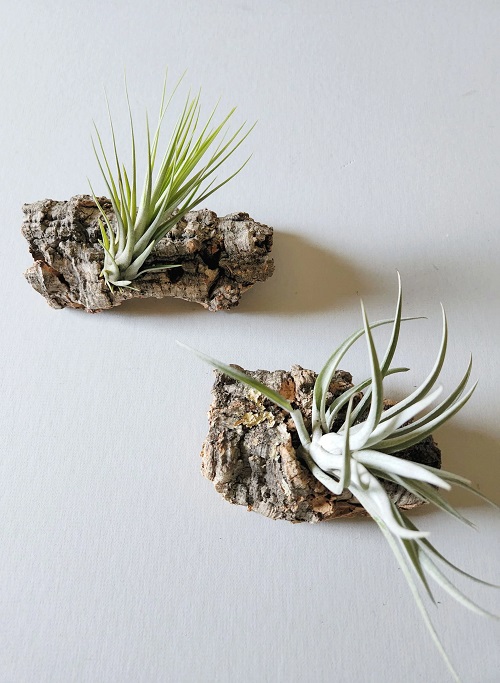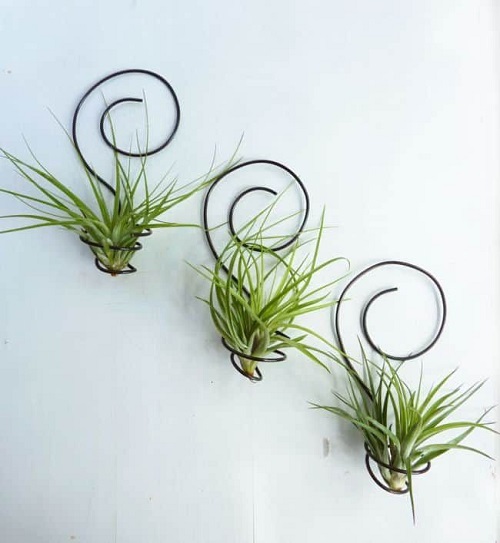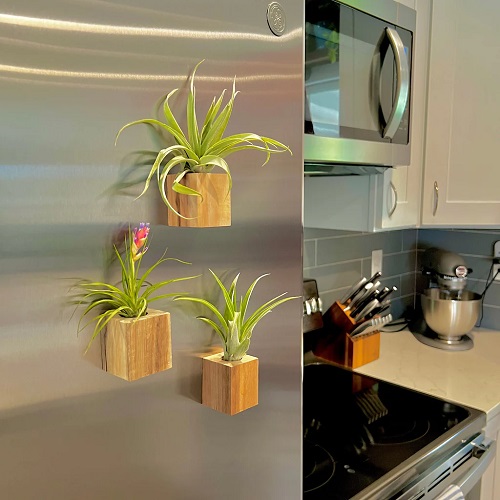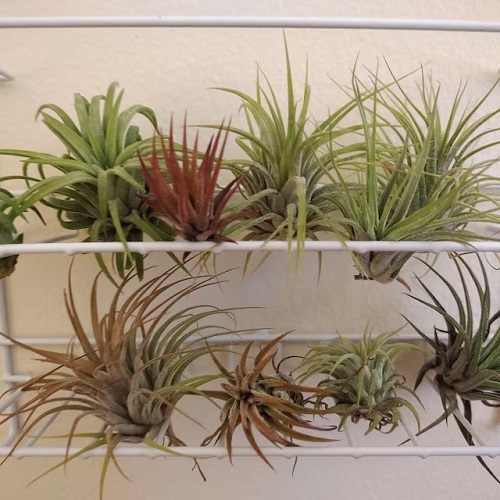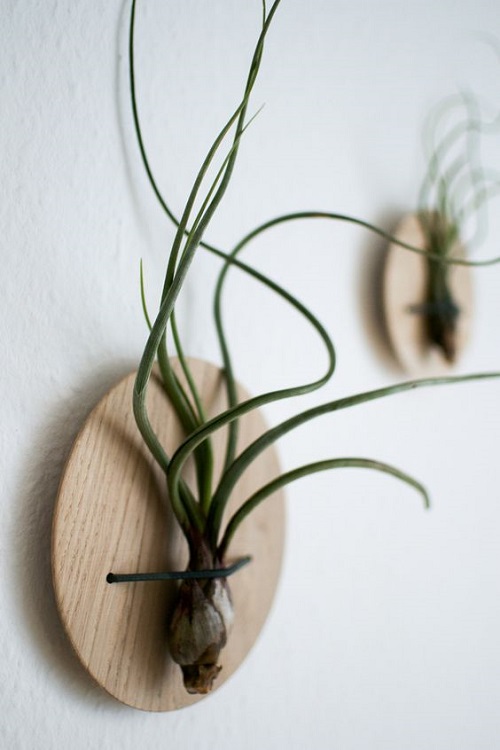Discover essential Tips for Mounting Air Plants in this helpful guide. Learn how to care for these unique, low-maintenance plants.
Explore expert Tips for Mounting Air Plants in this informative guide. These low-maintenance plants can thrive on various surfaces; this guide will show you the tricks for keeping them healthy and happy in your living space.
Read About Air Plant Stricta Care here
Methods for Mounting Air Plants
1. Gluing
Using a plant-safe adhesive like clear, non-toxic glue or specialized air plant glue, you can attach the base of your air plant directly. Go for surfaces of your choice, like driftwood, rocks, or shells. Just apply a small amount of adhesive to the base of the air plant and press it firmly onto the chosen surface. Allow it to dry completely before displaying.
2. Wire Wrapping
Wrap thin, flexible wire (e.g., floral or craft wire) around the base of the air plant and attach the other end to your chosen mounting surface. Ensure it’s snug but not too tight to avoid damaging the plant. Twist the wire ends securely to the mounting surface.
3. Hanging Containers
Use hanging containers like glass terrariums, glass globes, or metal cages to display air plants. These containers can be framed from hooks or placed on flat surfaces. Arrange the air plant inside the container, securing it with wire, twine, or fishing line if necessary. Hang the container or place it on a suitable surface.
4. Magnetic Mounting
Glue small magnets to the base of your air plants, allowing you to display them on magnetic surfaces such as metal boards, refrigerators, or magnetic planters. Apply adhesive to the plant’s base and attach the magnets securely. Once dry, position the air plant on the magnetic surface.
5. Driftwood and Rocks
Natural elements like driftwood, rocks, and stones can be attractive mounts for air plants. These materials offer a rustic, organic look. Securely attach the air plant to the chosen piece of driftwood or rock using glue or wire, ensuring it is stable and balanced.
6. Vertical Gardens
Create a vertical garden or living wall by mounting air plants on a specially designed structure, such as a vertical planter or a frame with pockets. Insert the air plants into the pockets or holders on the vertical structure. Ensure they are stuck well and won’t fall out.
7. Cork Bark Mounting
Cork bark pieces provide a natural and textured surface for mounting air plants. They are especially popular for mounting larger air plant species. Attach the air plant to the cork bark using glue or wire.
8. Wire Grids
Metal wire grids or mesh panels can mount air plants in various artistic arrangements. They are suitable for both indoor and outdoor displays. Experiment with different placements and angles for an artistic look.
9. Repurposed Items
Get creative by repurposing old picture frames, window frames, or vintage objects to mount your air plants, adding a unique and nostalgic charm to your display. Adapt the chosen item to accommodate the air plant securely, whether by attaching hooks, wire, or other fasteners.
Check Out How to Attach Air Plants to Wood here
How to Water Mounted Air Plants
Watering Mounted Air Plants require a delicate balance to ensure their health and longevity. Unlike traditional potted plants, air plants lack soil and have unique moisture-absorbing structures called trichomes on their leaves.
To water Mounted Air Plants effectively, it’s essential to remove them from their mounts and soak them in room-temperature water for about 20-30 minutes every 1-2 weeks, depending on your environment’s humidity. This method allows the plants to absorb the moisture they need through their trichomes and ensures they receive adequate hydration. After the soaking period, gently shake off excess water to prevent rot and mold, and then allow the air plants to air dry thoroughly before returning them to their mounts.
Read About Velutina Air Plant Care here
Lifespan of Mounted Air Plants
When properly cared for, Mounted Air Plants can live a healthy and long life similar to those grown in pots or containers. However, it’s essential to provide the appropriate care and attention they require to thrive.
Mounted Air Plants have the potential for a full and flourishing life when their specific needs are met. Factors such as proper watering, suitable lighting, adequate ventilation, and stable attachment to their mounts are pivotal in determining their longevity. Neglecting these care aspects can lead to stress, damage, or dehydration, which may impact their lifespan.
Read About How to Tell If An Air Plant is Dead here
Tips for Mounting Air Plants
1. Select the Right Base
The choice of base material is crucial for both aesthetics and stability. Consider materials like driftwood, rocks, seashells, or wireframes that align with your decor style and provide a secure foundation for the air plant.
2. Air Circulation
Adequate air circulation is essential for air plants. Ensure that the mounting base allows air to flow around the plant, preventing moisture buildup that can lead to rot.
3. Secure Attachment
Use a safe and non-toxic adhesive like plant glue, fishing line, or specialized air plant glue to attach your air plant to the base securely. Be gentle during this process to avoid damaging the plant.
4. Light
Air plants typically thrive in bright, indirect light. Some can tolerate brief periods of direct sunlight, but prolonged exposure may scorch their leaves. Place them in a location with suitable lighting conditions.
5. Water
Air plants absorb water and nutrients through their leaves, so misting or soaking is the preferred watering method. Submerge the plant in water for 20-30 minutes every 1-2 weeks, depending on the humidity of your environment. Afterward, gently shake off excess water to prevent rot.
6. Fertilize Sparingly
Use a diluted, water-soluble air plant fertilizer formulated specifically for tillandsias. Apply it every 2-4 weeks during the growing season to provide essential nutrients.
7. Rotate for Even Growth
To prevent your air plant from growing lopsided, rotate it periodically. This ensures that all sides of the plant receive an even amount of light.
8. Avoid Copper and Rust
Air plants can be sensitive to copper and rust. Be cautious when using copper wire or materials prone to rust, as they can harm the plant over time. Stick to non-corrosive materials.
Explore Harrisii Air Plant Care Guide here
Frequently Asked Questions
Q: What are some creative ways to mount air plants?
There are numerous creative ways to mount air plants, including driftwood, rocks, seashells, wire grids, hanging containers like terrariums, cork bark, vertical gardens, and even repurposed items like old picture frames. The choice depends on your aesthetic preferences and the environment you want to create.
Q: What is the best way to attach air plants to their mounts?
You can attach air plants to their mounts using plant-safe adhesives like clear or specialized air plant glue. Wire wrapping is another method where you gently secure the base of the plant with thin, flexible wire. Ensure a stable attachment to prevent the plant from falling.
Q: Can I display mounted air plants outdoors?
You can display mounted air plants outdoors but consider your local climate and weather conditions. Ensure they are protected from extreme heat, direct sunlight, frost, and heavy rain, as these factors can stress or damage the plants.
Q: How do I prevent my mounted air plants from falling or getting damaged?
To prevent air plants from falling or getting damaged, ensure they are securely attached to their mounts using appropriate methods like glue or wire. Regularly inspect their attachment and adjust as needed to maintain stability.
Q: Can I mount different species of air plants together?
Yes, you can mount different species of air plants together for visually appealing displays. Be mindful of their care requirements, as different species may have varying light and watering needs—group plants with similar care requirements to ensure their well-being.

